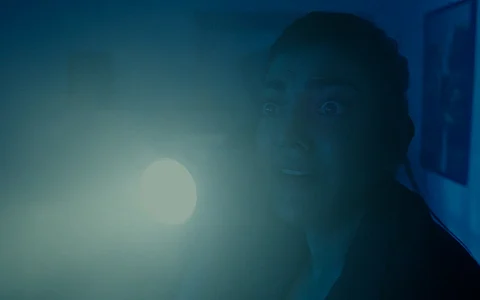
- In-Depth Stories
- Web Stories
- Reviews
- News
- FC Lists
- Interviews
- Features
- FC SpecialsFC Specials

Writer, Director: Venkat Prabhu
Cast: Kajal Aggarwal, Vaibhav, Kayal Anandhi, Selva, Priyanka
Producer: V Rajalakshmi
Streaming Platform: Disney+Hotstar
From the get-go, it is understood that the horror-moments will be a problem in Live Telecast. Nothing strikes, strums, or even stutters. The horror that opens the show plays out lazily, sketched with minimal mystery and awkward staging. Everyone is fussy, screechy, and confused. What is happening? Cut-to, flashback.
Jenny (Kajal Aggarwal) is in charge of a show that recreates "real-life" stories of horror, where the double-quotations imply how she morphs reality by adding sex and sensuality, changing the ending, to create a product that is trending. This, according to her, is a show of "international standards". Jenny is a wild spirit, and there are enough visual cues—smoking joints, cussing in the office, and a tattoo that says "wild flower" on her midriff. The performative coolness doesn't show, in her or her show. There's something very odd about the episodes she directs. At one point a woman, filmed smoking, showering, and then in bed in her silk red nightdress, is suddenly unclothed by the ghost. Here's a frisky one. The noises the woman makes struggling are like those in a rape scene, and the act of possession is played out as such. This episode trends for the wrong reason, and under pressure from sponsors, the show is shut.

To resurrect her career and those of her team, each of whom we are introduced to in a lazy breaking of the fourth wall, they decide to go to an actual haunted house, to shoot and capture the ghosts on live television. This too isn't "reality", because she dresses people up as ghosts to run across the live-stream camera. But then, the real one shows up, and the fussy, screechy, confused team cries in chorus—what is happening? ("What if Bigg Boss goes wrong? That is the concept," the director has noted in interviews.)

This—when the real horror begins—is where the show flounders. The previous episodes, providing context to the team—their romances, their reticence—even as it is written lazily, with little feeling, has a halo of intrigue because it keeps moving from one facile set-up to the next. (It is also deeply inconsistent. In one scene the car shown is a Renault hatchback. In the next scene, the same car has suddenly become a Maruti Suzuki sedan.) But as soon as you contain the entire cast in one house, the story doesn't move, and it is entirely dependent on horror, and Kajal Aggarwal's wide-eyed antics to be engaging. This structural flaw in the writing is obvious because the direction of the horror lacks, well, horror.
With horror, the camera needs to be slippery—as a viewer you shouldn't know if the camera perspective is that of a ghost, or that of the neutral camera. It also needs to have a spring in its step, a dynamism that calls into question its very identity. Here, no such effort is made. The sound design is flaccid, and even the lighting is poor. Much of the film unravels in darkness and the poorly lit spaces which makes for a squint-eyed watch.
Out of the 7 half-hour long episodes, a few are set entirely in the house, on the narrative crutch of jump scares which don't deliver. The ghost plays musical chairs, possessing one person now, and another person within a minute. Dead people come alive, and alive people have the screen presence of the dead. The scenes are directionally vague, and after a point you lose interest in their existential fight. The customary flashback to explain the origin story of the ghost is bunged in like a footnote in the last 15 minutes. If the horror preceding it hadn't been so ennui-inducing, there would be offense to be taken at such a lazy back-story.
This is all taking place live, and the scenes of massacre are being played out on people's televisions as grandparents and grandchildren watch, and young men jostle with the idea of its reality. The effect of voyeurism and the chase for TRPs, the belief in something that cannot be seen, and the fear of what cannot be controlled, all come together as a tepid moral underlying this horror series. A nobleness that is undone by incompetence.